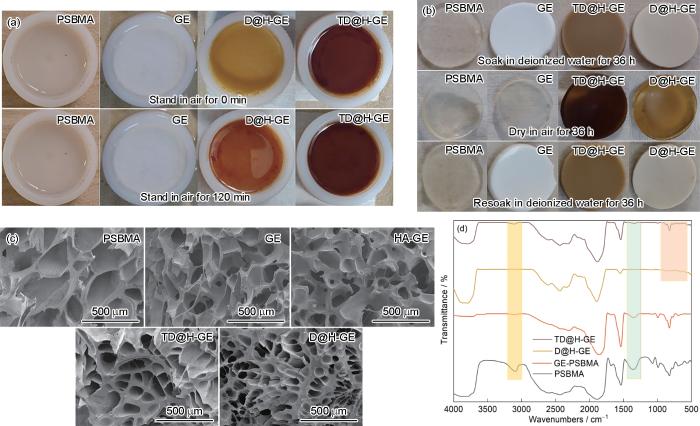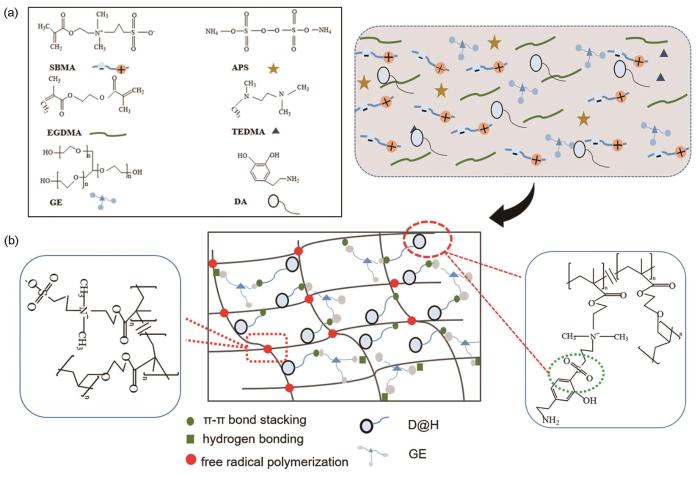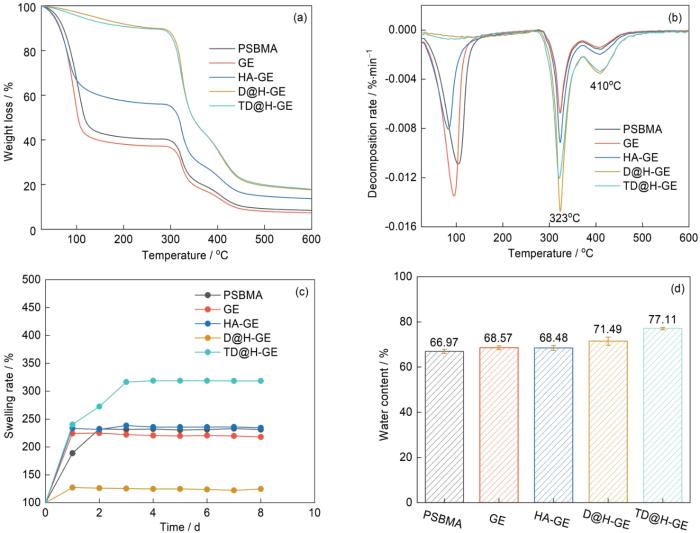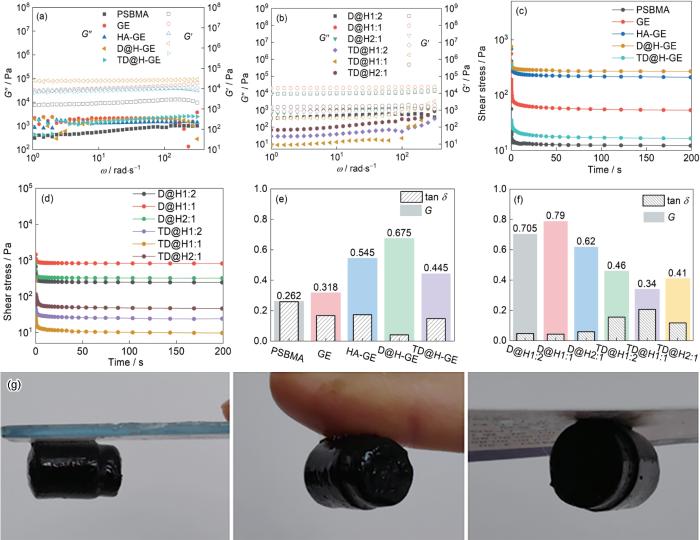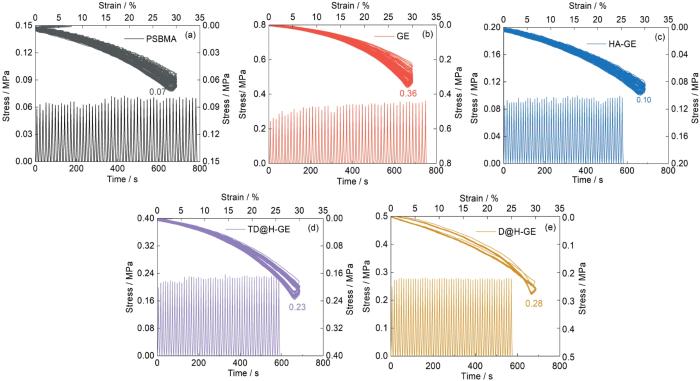关节软骨长期承载受力,产生的磨损不断积累使其变薄退化,不能提供正常的润滑,影响关节软骨细胞的正常生长增殖[1]。使用合成关节软骨仿生材料,可治疗骨关节炎。但是,这种合成的关节软骨必须具有优异的机械性能和润滑性能。
甜菜碱两性离子水凝胶,具有高亲水性、高离子密度以及良好的防蛋白质和病菌粘附等优势[5],但是其力学性能较差,可提供的断裂压缩应力不到800 kPa[7]。近年来,研究者用纳米填充和网络结构改性等方法提高两性离子水凝胶的力学性能[8]。Chen等[10]制备甲基丙烯酸2-羟乙基酯-甲基丙烯酸磺基甜菜碱(HEMA-co-SBMA)复合水凝胶,添加单宁酸(TA)使其具有生物矿化和抗菌功能,且压缩力学性能(3 MPa)比纯poly-HEMA水凝胶(1.2 MPa)提高了2.5倍。Wang等[7]在两性离子水凝胶体系中加入氧化石墨烯纳米片(GO)制备出GO-PSBMA纳米复合水凝胶,其力学性能提高近5倍(0.36 MPa)。Jin等[11]添加丙烯酰胺(AAm)通过自由基共聚合制备的半互穿多功能水凝胶P(SBMA-co-AAm),其压缩强度达到140 kPa,且在0%~30%应变范围内具有较好的应变敏感性。这表明,填充无机纳米粒子和有机复合物能提高两性离子水凝胶的力学强度,但是其性能仍然不如天然软骨(3~18 MPa)。同时,无机纳米粒子表面能与有机物有很大差距,使其在两性离子水凝胶体系的分散性较差,影响两性离子水凝胶的微观网状结构,从而极大地影响两性离子水凝胶的宏观力学性能[12]。
羟基磷灰石(Hydroxyapatite,HA)是人体和动物骨骼的主要无机成分,能在人体内部分溶解释放无害的离子并参与体内代谢,刺激、诱导骨质增生和修复缺损组织[14]。但是,纳米级羟基磷灰石极易在水凝胶体系中团聚,影响水凝胶的力学性能[16]。具有良好改性能力的多巴胺(Dopamine,DA),能与有机、无机物质发生反应而提高材料的理化性质。李刚等[17]分别用多巴胺、聚乙二醇、壳聚糖等亲水性材料对HA改性,明显减弱其团聚现象。Wang等[18]掺杂纳米羟基磷灰石和氧化石墨烯结合丝素蛋白构建nHA-GO/SF纳米复合水凝胶,其拉伸性能达到18 MPa,压缩性能为10 kPa,且具有良好的生物相容性和促进成骨分化性能。但是,多巴胺在改性过程中的自我氧化程度难以控制。鉴于此,本文针对多巴胺改性自我氧化程度及两性离子水凝胶力学性能不足等问题,基于纳米填充方法,以多巴胺改性纳米羟基磷灰石作为添加剂,增强两性离子水凝胶的成型质量和力学性能,揭示DA对HA的改性作用和纳米复合水凝胶的合成机理,研究纳米复合水凝胶的理化性质与力学性能,分析添加剂与两性离子水凝胶之间的作用机制与影响因素。
1 实验方法
1.1 实验用材料
盐酸多巴胺(DA),98%;纳米羟基磷灰石(HA),≥ 98%、< 0.2 μm;Tris缓冲盐溶液(Tris buffer salt solution,Tris),pH 8.0;[2-(甲基丙烯酰基氧基)乙基]二甲基-(3-磺酸丙基)氢氧化铵(Sulfobetaine methacrylate,SBMA),97%;过硫酸铵(Ammonium persulfate,APS),99.99%;乙二醇二甲基丙烯酸酯(Ethylene glycol dimethacrylate,EGDMA),98%;四甲基乙二胺(Tetramethylethylenediamine,TMEDA),99%;无水乙醇(Ethanol),99.5%;甘油聚醚(Glycerol ethoxylate,GE),98%。
1.2 纳米粒子改性和复合水凝胶的制备
将质量分数为0.08%的DA和HA粉末按不同比例加到7 mL质量比为5∶1的去离子水与乙醇混合溶液中,在常温下以200 r/min的速度搅拌5 h,得到不同比例的酸性D@H纳米粒子混合溶液。再将DA和HA加到7 mL质量比为2∶2∶1的Tris缓冲液、去离子水和乙醇混合溶液中,搅拌20 min后获得不同比例的碱性TD@H纳米粒子混合溶液。
将质量分数为45.75%的EGDMA、2.8%的GE溶液和23.11%的SBMA以及0.18%APS粉末依次加到D@H混合溶液(DA与HA的质量比为5:3)。在室温下以450 r/min的速度搅拌3.5 h得到均匀分散的纳米复合水凝胶混合溶液,再加入60 μL的TMEDA,搅拌1~2 min后倒入模具中,在室温静置成型得到D@H-GE酸性纳米复合水凝胶。按与以上相同的方法,分别与TD@H纳米粒子、未改性的HA和酸性DA混合溶液共混获得TD@H-GE碱性纳米复合水凝胶、HA-GE复合水凝胶和DA-GE复合水凝胶。
1.3 性能表征
将D@H纳米粒子混合溶液在80℃干燥箱中烘干2 h得到D@H固体粉末,用红外光谱仪(iS10,尼高力)、拉曼光谱仪(DXR2,赛默飞)和X射线衍射仪(D8 ADVANCE,布鲁克)表征多巴胺的改性作用。将合成的复合水凝胶放在-20℃的真空冷冻干燥机(FDU-1100,EYELA)中冷冻48 h,再将其真空干燥一周以去除水分用于性能表征。用红外光谱仪分析纳米复合水凝胶的化学结构和D@H纳米粒子与水凝胶体系的结合方式。对冻干后的纳米复合水凝胶样品表面做喷金处理,用扫描电子显微镜(SEM,SU8020,日立)观察其微观结构和网络特征。
用热重分析仪(TGA/DSC3+,梅特勒-托利多)分析复合水凝胶在25℃~600℃范围内的质量损失、D@H和TD@H纳米粒子对复合水凝胶结构的热稳定性以及复合水凝胶与内部水相互作用力,升温速率为10 ℃/min。
将质量为m0的D@H和TD@H纳米粒子对复合水凝胶样品浸泡在磷酸盐缓冲液(Phosphate buffer,PBS)中,每隔24 h更换一次并测量样品的质量(mt),复合水凝胶的溶胀率为
PBS缓冲液溶胀平衡后将其置于真空冻干机制成无水固体,测出冻干后的质量(m1),则冻干过程的失重率为
用力学试验机(恒旭)测试纳米复合水凝胶的压缩强度。将所有样品在离心管中成型,其直径为9 mm、长为15 mm。以50 mm/min的速度压缩试样至断裂(或30%应变下循环100次),根据应力σ-应变ε结果评价复合水凝胶的压缩强度和抗压缩疲劳性能。
用旋转流变仪(MCR301,安东帕)测试复合水凝胶承受剪切力时的状态。将复合水凝胶制备直径为20 mm、厚度为1.5 mm的圆片,使用PP20转子在初始剪切应变(γ)为1%,角速度(ω)为0.314~314 rad/s。观察其储能模量(G′)和损耗模量(G″)的变化,分析其动态流变性能;在恒定剪切应变(γ)为10%的条件下分析复合水凝胶的静态流变性能。
2 结果和讨论
2.1 多巴胺改性和纳米复合水凝胶的合成机理
图1给出了DA、HA和D@H的红外谱、拉曼谱和XRD谱的表征结果以及烘干后的D@H和TD@H粉末图示。在DA的红外光谱(图1a)中的1539 cm-1、1402 cm-1出现的是苯环骨架的特征峰值,在987 cm-1、860 cm-1、704 cm-1出现的是苯环上取代官能团的-CR特征峰[19]。在HA的红外光谱中3543 cm-1出现了-OH的特征峰,在896 cm-1、790 cm-1出现了PO
图1
图1
D@H改性后的红外光谱、拉曼光谱、XRD谱以及改性纳米粒子干燥后的粉末图示
Fig.1
D@H modification effect (a) infrared spectrum results, (b) raman spectrum results, (c) XRD spectrum results and (d) powder diagram of modified nanoparticles after drying
PSBMA两性离子水凝胶是无色透明的,添加GE后的共混水凝胶是不透明的乳白色。添加改性纳米粒子后TD@H-GE纳米复合水凝胶为不透明的黑棕色,而D@H-GE纳米复合水凝胶从不透明的黄棕色逐渐变成不透明的橘黄色(图2a)。所有水凝胶溶胀失水后是透明的,但是置于去离子水中恢复为不透明的(图2b)。图2c给出了D@H-GE和TD@H-GE纳米复合水凝胶的SEM形貌。可以看出,加入D@H纳米粒子未改变水凝胶的多孔网络结构,但是与PSBMA两性离子水凝胶和GE-PSBMA共混水凝胶相比,纳米复合水凝胶的孔隙尺寸减小、交联密度更均匀。图2d给出了D@H-GE和TD@H-GE纳米复合水凝胶的红外光谱。可以看出,在纯PSBMA和GE-PSBMA共混水凝胶的红外光谱中,在~1850 cm-1出现了C=O特征峰,在~1680 cm-1出现了C=C特征峰,在~1550 cm-1出现了-NH特征峰,而在~3700 cm-1、3149 cm-1处未出现GE-PSBMA共混水凝胶的-OH特征峰。结合其溶胀前后的颜色变化可逆,表明存在氢键相互作用[23]。同时,在D@H-GE和TD@H-GE纳米复合水凝胶的红外光谱中的~3100 cm-1、~1060 cm-1处未出现C=C、S=O特征峰,而在800 cm-1~550 cm-1出现的苯环取代官能团峰也不明显。这表明,在酸或碱性条件下DA与SBMA高分子链上的SO
图2
图2
水凝胶的表面颜色和在空气中静置后表面颜色的变化、水凝胶溶胀后静置在空气中颜色的变化、水凝胶的微观结构以及水凝胶的红外光谱
Fig.2
Changes in the surface color of hydrogel and the color of the surface standing in the air (a), changes in the color of the hydrogel standing in the air after swelling (b), microstructure of the hydrogel (c) and the infrared spectrum of the hydrogel (d)
以上结果表明,在酸性和碱性条件下纳米复合水凝胶均发生自由基聚合反应形成交联网络(图3),且SBMA分子链与改性纳米粒子中的多巴胺苯环通过共价连接结合,GE与水凝胶体系形成氢键相互作用并与多巴胺氧化形成π-π键堆积相互吸引。
图3
图3
水凝胶组分结构和纳米复合水凝胶合成机理的图示
Fig.3
Diagram of composition structure of hydrogel (a) and diagram of synthesis mechanism (b) of nanocomposite hydrogel
2.2 纳米复合水凝胶的理化性质
水凝胶是一种软湿类亲水材料,其理化性质、力学强度和润滑性能取决于其三维网络结构以及内部水的相互作用。图4a给出了纳米复合水凝胶的质量损失率随温度的变化,可见其在酸或碱性条件下的变化趋势相似。质量损失率与水凝胶的交联密度有关,质量损失率越低表明其网络结构越稳定[28]。在75℃~150℃的质量损失对应水凝胶材料中水的蒸发,在200℃~500℃的质量损失对应不同聚合物的分解[29]。纳米复合水凝胶低于150℃的质量损失率最低,而未添加改性纳米粒子的水凝胶质量损失比较显著。样品的分解速率曲线(图4b)表明,所有的水凝胶在323℃、410℃出现明显的质量损失峰,表明出现相似结构的分解,即添加改性纳米粒子没有明显改变水凝胶的主要交联网络结构[30]。这表明,纳米复合水凝胶具有稳定的网络结构、较强的保水性质和优异的热稳定性。
图4
图4
水凝胶的基本理化性质
Fig.4
Basic physical and chemical properties of hydrogel (a) weight loss rate versus temperature curve, (b) weight loss rate curve, (c) swelling rate and (d) freeze drying water content
2.3 纳米复合水凝胶的力学性能
外力的作用使水凝胶的微观网络变形,表征其内部结构强度。受到外力作用时,高分子链网络结构发生变形产生内部应力,使整体结构发生变化[33]。测定水凝胶的储能模量G′和耗散模量G″随角频率ω的变化并分析其粘弹性能,可评价水凝胶的抗振动冲击能力[34]。同时,在产生10%剪切应变的情况下观察在酸、碱条件下纳米复合水凝胶的剪切应力随时间的变化,分析其网络结构的弹塑性变形能力,如图5所示。可以看出,D@H-GE纳米复合水凝胶的G′最高(2.5 MPa),远大于G″ (图5a),且能在产生恒定剪切应变的情况下迅速建立新平衡并维持较大的剪切应力(268.9 Pa)(图5c)。DA与HA的质量比也影响其流变性能(图5b)。随着质量比的增大,D@H-GE纳米复合水凝胶的储能模量G′和剪切应力先增大后减小,耗散模量G″随角频率ω的变化未出现明显的波动,D@H1:1纳米复合水凝胶的流变性能最好;而TD@H纳米复合水凝胶的储能模量G′和剪切应力先减小后增大,耗散模量G″随着角频率ω的提高而增大。
图5
图5
添加剂含量不同的水凝胶的储能模量G′和耗散模量G″随角速度ω的变化、DA与HA质量比不同的纳米复合水凝胶储能模量G′和耗散模量G″随角速度ω的变化、添加剂含量不同的水凝胶的应力松弛实验结果、DA与HA质量比不同的纳米复合水凝胶的应力松弛实验结果、添加剂含量不同的水凝胶的损耗因子tan δ和归一化松弛模量G、DA与HA质量比不同的水凝胶的损耗因子tan δ和归一化松弛模量G以及TD@H-GE纳米复合水凝胶的粘附性
Fig.5
Storage modulus G′ and dissipation modulus G″ of hydrogel with different additives versus angular velocity ω (a), the storage modulus G′ and dissipation modulus G″ of nanocomposite hydrogels with different mass ratios of DA to HA vary with angular velocity ω (b), stress relaxation test results of hydrogels with different additives (c), stress relaxation test results of nanocomposite hydrogels with different DA/HA mass ratios (d), loss factor tan of hydrogels with different additives δ And normalized relaxation modulus G (e), loss factor tan of hydrogels with different mass ratio of DA/HA δ Normalized relaxation modulus G (f) and TD@H-GE adhesion of nanocomposite hydrogels (g)
基于以上的流变结果,可计算水凝胶的损耗因子
和归一化松弛模量[35]
HA-GE复合水凝胶的tan δ比GE-PSBMA共混水凝胶的大(图5e),其内耗能力降低。这表明,HA在GE-PSBMA共混水凝胶体系中发生了团聚[16],影响网络结构的均匀性。而D@H-GE纳米复合水凝胶的tan δ为0.041,归一化松弛模量为0.675,表现出最强的内耗能力和粘弹特性。随着DA与HA质量比的提高D@H-GE纳米复合水凝胶的内耗能力和粘弹性能先增大后减小,而TD@H-GE纳米复合水凝胶的变化趋势与其相反(图5f)。这表明,添加D@H纳米粒子促进了复合水凝胶三维网络结构交联的形成,显著提高了水凝胶的网络结构强度[36]。同时发现,TD@H-GE纳米复合水凝胶具有较好的粘附性(图5g)。
图6给出了纳米复合水凝胶的抗压缩断裂实验结果。D@H改性纳米粒子显著增强了水凝胶的抗压缩断裂能力,其压缩断裂应力达到11.66 MPa,HA-GE复合水凝胶的压缩断裂应力仅为2.90 MPa,而DA-GE复合水凝胶的压缩断裂应力为7.20 MPa。这表明,在酸性条件下DA对HA的改性显著提高了HA在复合水凝胶中的分散性[22]。同时,DA的氧化增多了改性纳米粒子的交联点,使D@H-GE纳米复合水凝胶的孔隙尺寸更小,网络结构更均匀(SEM结果),从而使其具有优异的机械性能[37]。TD@H-GE纳米复合水凝胶的压缩断裂应力为5.98 MPa,进一步证明在酸性条件下纳米粒子改性可控制DA的自我氧化反应,促进DA与GE-PSBMA共混水凝胶体系形成良好的交联网络[21]。
图6
图6
添加剂不同的水凝胶的压缩断裂实验结果和DA与HA质量比不同的纳米复合水凝胶的压缩断裂实验结果
Fig.6
Compression fracture test results of hydrogels with different additives (a) and nanocomposite hydrogels with different mass ratios of DA/HA (b)
DA与HA质量比的不同,也使复合水凝胶的力学性能显著不同。随着质量比的增大压缩断裂应力先增大后减小。D@H1:1纳米复合水凝胶的抗断裂压缩应力最强为6.03 MPa,约为同比例TD@H1:1的1.7倍。这表明,在酸性条件下DA的改性过程中更长的搅拌时间(5 h)使DA氧化速率较低,能在HA表面形成均匀的氧化膜。当质量比较小时,较低含量的DA不能在HA表面完全形成氧化膜,而更大比例的DA又过度氧化,没有良好的改性作用。
图7
图7
几种水凝胶的压缩循环实验结果
Fig.7
Compression cycle test results of hydrogel (a) PSBMA hydrogel (b) GE-PSBMA comixed hydrogel (c) HA-GE nanocomposite hydrogel (d) TD@H-GE nanocomposite hydrogel (e) D@H-GE nanocomposite hydrogel
3 结论
(1) 在酸性条件下可制备D@H改性纳米粒子,控制DA的自我氧化程度使HA在水凝胶体系的分散性显著提高。
(2) SBMA分子链能与改性纳米粒子中的多巴胺苯环发生共价连接,且GE与多巴胺氧化形成π-π键堆积相互吸引。添加D@H改性纳米粒子改善了水凝胶的交联网络结构,提高水凝胶的交联密度、减小水凝胶的孔隙尺寸和提高了水凝胶与其内部水分子的相互作用力和热稳定性。
(3) D@H-GE纳米复合水凝胶的内耗能力和粘弹性能最好,且随着DA与HA质量比的提高其内耗能力和粘弹性能先增大后降低,而TD@H-GE纳米复合水凝胶变化趋势与其相反。
(4) D@H5:3纳米复合水凝胶具有优异的抗力学压缩性能且在恒定应变压缩循环下D@H-GE纳米复合水凝胶具有更好的应力应变响应和抗压缩疲劳性能。
参考文献
High-efficient engineering of osteo-callus organoids for rapid bone regeneration within one month
[J].
Biofabrication of multifunctional nanocellulosic 3D structures: a facile and customizable route
[J].
Biomimetic injectable hydrogel microspheres with enhanced lubrication and controllable drug release for the treatment of osteoarthritis
[J].The occurrence of osteoarthritis (OA) is highly associated with the reduced lubrication property of the joint, where a progressive and irreversible damage of the articular cartilage and consecutive inflammatory response dominate the mechanism. In this study, bioinspired by the super-lubrication property of cartilage and catecholamine chemistry of mussel, we successfully developed injectable hydrogel microspheres with enhanced lubrication and controllable drug release for OA treatment. Particularly, the lubricating microspheres (GelMA@DMA-MPC) were fabricated by dip coating a self-adhesive polymer (DMA-MPC, synthesized by free radical copolymerization) on superficial surface of photo-crosslinked methacrylate gelatin hydrogel microspheres (GelMA, prepared via microfluidic technology), and encapsulated with an anti-inflammatory drug of diclofenac sodium (DS) to achieve the dual-functional performance. The tribological test and drug release test showed the enhanced lubrication and sustained drug release of the GelMA@DMA-MPC microspheres. In addition, the functionalized microspheres were intra-articularly injected into the rat knee joint with an OA model, and the biological tests including qRT-PCR, immunofluorescence staining assay, X-ray radiography and histological staining assay all revealed that the biocompatible microspheres provided significant therapeutic effect against the development of OA. In summary, the injectable hydrogel microspheres developed herein greatly improved lubrication and achieved sustained local drug release, therefore representing a facile and promising technique for the treatment of OA.© 2021 The Authors.
Mechanical and microscopical characterisation of bilayer hydrogels strengthened by TiO2 nanoparticles as a cartilage replacement candidate
[J].
Reversibly highly stretchable and self‐healable zwitterion‐containing polyelectrolyte hydrogel with high ionic conductivity for high‐performance flexible and cold‐resistant supercapacitor
[J].
Fabrication of ALGINATE‐P (SBMA‐CO-AAM) hydrogels with ultrastretchability, strain sensitivity, self-adhesiveness, biocompatibility, and self-cleaning function for stra-in sensors
[J].
Zwitterionic hydrogel incorporated graphene oxide nanosheets with improved strength and lubri-city
[J].
PVA-BA/PEG hydrogel with bilayer structure for biomimetic articular cartilage and investigation of its biotribological and mechanical properties
[J].
Preparation and enhanced mechanical properties of hybrid hydrogels comprising ultralong hydroxyapatite nanowires and sodium alginate
[J].
Biomimetic mineralization of tannic acid-supplemented HEMA/SBMA nanocomposite hydrogels
[J].
Fabrication of alginate‐P (SBMA‐co‐AAm) hydrogels with ultrastretchability, strain sensitivity, self‐adhesiveness, biocompatibility, and self‐cleaning function for strain sensors
[J].
In-situ synthesis and characterization of poly(vinyl alcohol)/hydroxyapatite composite hydrogel by freezing-thawing method
[J].
The Effect of ζ‐potential and hydrodynamic size on nanoparticle interactions in hydrogels
[J].
A GelMA-PEGDA-nHA composite hydrogel for bone tissue engineering
[J].
In situ mineralization of nano-hydroxyapatite on bifunctional cellulose nanofiber/polyvinyl alcohol/sodium alginate hydrogel using 3D printing
[J].This paper reports the manufacturing by 3D printing of scaffolds for in-situ mineralization of hydroxyapatite using aqueous suspensions of alginate and polyvinyl alcohol (PVA)-grafted cellulose nanofibers (CNF). Bifunctional CNF with carboxyl and aldehyde moieties were prepared from bleached bagasse pulp and crosslinked with PVA. Aqueous hydrogels for 3D printing were prepared by directly mixing PVA-grafted CNF with sodium alginate, with and without the addition of phosphate ions. A calcium chloride solution was sprayed during the printing process in order to partially crosslink alginate and to increase the dimensional stability of the printed gel. At the end of the printing process, the prepared scaffolds were dipped into a CaCl solution to: i) complete alginate crosslinking and ii) promote hydroxyapatite nucleation and growth by reaction with phosphate ions. In order to better understand the mechanisms governing manufacturing of scaffolds by 3D printing, the rheological behavior of alginate/PVA-grafted CNF and the mechanical properties of unit filaments obtained by direct hydrogel extrusion were investigated. The final scaffolds were characterized by scanning electron microscopy (SEM), Fourier transform infrared spectroscopy (FTIR) and thermogravimetric analysis (TGA). This study shows that 3D printed sodium alginate/PVA-grafted CNF hydrogels are promising scaffold materials for bone tissue engineering.Copyright © 2020 Elsevier B.V. All rights reserved.
Study on compressive mechanical properties of nanohydroxyapatite reinforced poly (vinyl alcohol) gel composites as biomaterial
[J].
Effect of surface modification of nano-hydroxyapatite on the dispersion of hydrophilic modifier
[J].
亲水改性剂表面修饰纳米羟基磷灰石对其分散性的影响
[J].
Synergic adhesive chemistry-based fabrication of BMP-2 immobilized silk fibroin hydrogel functionalized with hybrid nanomaterial to augment osteogenic differentiation of rBMSCs for bone defect repair
[J].Bone defect repair and tissue engineering is specifically challenging process because of the distinctive morphological and structural behaviours of natural bone with complex healing and biochemical mechanisms. In the present investigation, we designed dopamine adhesive chemistry-based fabrication of silk fibroin hydrogel (SFD) with incorporation of nano-hydroxyapatite (nHA)-graphene oxide (GO) hybrid nanofillers with well-arranged porous morphology immobilized with bone morphogenic protein-2 (BMP-2) for the effective in vitro rabbit bone marrow derived mesenchymal stem cells loading compatibility and in vivo new bone regrowth and collagen deposition ability. We have achieved bone-specific hydrogel scaffolds with upgraded structural features, mechanical properties and particularly promoted in vitro osteogenic differentiation and compatibility of rabbit bone marrow mesenchymal stem cells (rBMSCs). Structural and microscopic analyses established greater distributions of components and well-ordered and aligned porous structure of the hydrogel network. In vivo result of new bone regrowth was promisingly higher in the Bm@nHG-SFD hydrogel (85%) group as compared to the other treatment groups of nHG-SFD (77%) and nH-SFD (64%) hydrogel. Overall, we summarized that morphologically improved hydrogel material with immobilization of BMP-2 could be have more attentions for new generation bone regeneration therapies.Copyright © 2018. Published by Elsevier B.V.
Tough thermosensitive hydrogel with excellent adhesion to low-energy surface developed via nanoparticle-induced dynamic crosslinking
[J].
In-situ synthesis and characterization of poly(vinyl alcohol)/hydroxyapatite composite hydrogel by freezing-thawing method
[J].
A plant-inspired long-lasting adhesive bilayer nanocomposite hydrogel based on redox-active Ag/Tannic acid-Cellulose nanofibers
[J].
Preparation and physicochemical properties of an injectable alginate-based hydrogel by the regulated release of divalent ions via the hydrolysis of D-glucono-δ-lactone
[J].
Macroscale superlubricity achieved between zwitterionic copolymer hydrogel and sapphire in water
[J].
Low-friction hybrid hydrogel with excellent mechanical properties for simulating articular cartilage movement
[J].Hydrogels, which can withstand large deformations and have stable chemical properties, are considered a potential material for cartilage repair. However, hydrogels still face some challenges regarding their mechanical properties, tribological behavior, and biocompatibility. Thus, we synthesized a hybrid hydrogel by means of chemical cross-linking and transesterification using glycerol ethoxylate (GE) and zwitterionic polysulfobetaine methacrylate (PSBMA) as raw materials. The hybrid hydrogel showed excellent compressive stress at approximately 3.50 MPa and low loss factors (0.023-0.049). Moreover, because GE has good water binding properties, helping to form a stable hydration layer and maintain low energy dissipation, a low friction coefficient (μ ≈ 0.028) was obtained with the "soft-soft contact mode" of a hydrogel hemisphere and hydrogel disc under reciprocating motion. In vitro cytotoxicity, skin sensitization, and irritation reaction tests were carried out to show good biocompatibility of the GE-PSBMA hybrid hydrogel. In this study, a hybrid hydrogel with no potential cytotoxicity, strong compressive capacity, and excellent lubricity was obtained to provide a potential alternative for developing polymer hybrids, as well as demonstrating an idea for the application of hybrid hydrogels in cartilage replacement.
Mussel-inspired adhesive and conductive hydrogel with long-lasting moisture and extreme temperature tolerance
[J].
Dopamine-initiated photopolymerization for a versatile catechol-functionalized hydrogel
[J].Biomimetic catechol-functionalized hydrogels have attracted substantial attention due to their potential in a variety of biomedical applications, such as tissue repair and regeneration, drug delivery, and antimicrobial and antifouling applications. In this study, a one-pot strategy for fabrication of functional catecholic hydrogels using dopamine as a photoinitiator was developed. Under UV irradiation in an acidic solution, dopamine generates free radicals, likely semiquinone radicals, to trigger the addition polymerization, following pseudo-first-order kinetics. The dopamine-initiated photopolymerization provides a straightforward and facile approach and, in addition, prevents the undesirable oxidation to catecholic groups. Superhydrophilic sulfobetaine methacrylate (SBMA) was applied for developing biocompatible hydrogels. H nuclear magnetic resonance, UV-vis spectroscopy, gel permeation chromatography, and rheological studies were conducted to explore the polymerization mechanism and optimal experimental conditions in terms of pH, UV doses, and the concentration of dopamine. The unique properties of the resultant catechol-functionalized pSBMA hydrogels were demonstrated by enhanced mechanical properties through metal-catechol complexation, self-healing and injectable capability, high adhesiveness, and fouling resistance. Consequently, the synthetic strategy to design catecholic hydrogels can leverage the use of dopamine in a variety of applications.
Synthesis and characterization of multifunctional organic-inorganic composite hydrogel formed with tissue-adhesive property and inhibiting infection
[J].
Thermosensitive hydrogel for encapsulation and controlled release of biocontrol agents to prevent peanut aflatoxin contamination
[J].
Preparation of bacterial cellulose/silk fibroin double-network hydrogel with high mechanical strength and biocompatibility for artificial cartilage
[J].
Tuning the pH‐responsiveness capability of poly(acrylic acid‐co‐itaconic acid)/NaOH hydrogel: Design, swelling, and rust removal evaluation
[J].
Synthesis and characterization of poly(vinyl alcohol)/chondroitin sulfate composite hydrogels containing strontium‐doped hydroxyapatite as promising biomaterials
[J].
Versatile surface modification of millimeter‐scale “aqueous pearls” with nanoparticles via self‐polymerization of dopamine
[J].
Deoxycholic acid and l-Phenylalanine enrich their hydrogel properties when combined in a zwitterionic derivative
[J].
Non-linear rheological study of hydrogel sliding friction in water and concentrated hyaluronan solution
[J].
Dual-cross-linked network hydrogels with multiresponsive, self-healing, and shear strengthening properties
[J].Dual-cross-linked network (DCN) hydrogels with multiresponsive and self-healing properties are attracting intensive interests due to their enhanced mechanical strength for a wide range of applications. Herein, we developed a DCN hydrogel that combines a dynamic imine and a benzoxaboronic ester with a neutral p value (∼7.2) as dual linkages and contains biocompatible zwitterionic poly(2-methacryloyloxyethyl phosphorylcholine) [poly(MPC)] as the backbone. Oscillatory rheology result indicated shear strengthening mechanical properties compared to the single-cross-linked network (SCN) hydrogels, which use either imine bond or benzoxaboronic ester as the linkage alone. Due to the coexistence of stimuli-responsive imine and benzoxaboronic ester, the DCN hydrogels show sensitive multiple responsiveness to pH, sugar, and hydrogen peroxide. The dynamic nature of the dual linkages endows the DCN hydrogels with excellent self-healing ability after fracture. More importantly, the excellent biocompatibility and performance in three-dimensional (3D) cell encapsulation were established by a cytotoxicity Live/Dead assay, indicating DCN hydrogel's great potential as a cell culture scaffold. The biocompatible poly(MPC)-based backbone and the rapid formation of the cross-linking network make the DCN hydrogels promising candidates for future biomedical applications.
structure, morphology, and rheology of polyelectrolyte complex hydrogels formed by self-assembly of oppositely charged triblock polyelectrolytes
[J].
The effect of water content on the elastic modulus and fracture energy of hydrogel
[J].
Highly elastic anti-fatigue and anti-freezing conductive double network hydrogel for human body sensors
[J].
An electrochemically neutralized energy-assisted low-cost acid-alkaline electrolyzer for energy-saving electrolysis hydrogen generation
[J].
An anti-pressure, fatigue-resistant and rapid self-healing hydrogel based on a nano-micelle assem-bly
[J].





